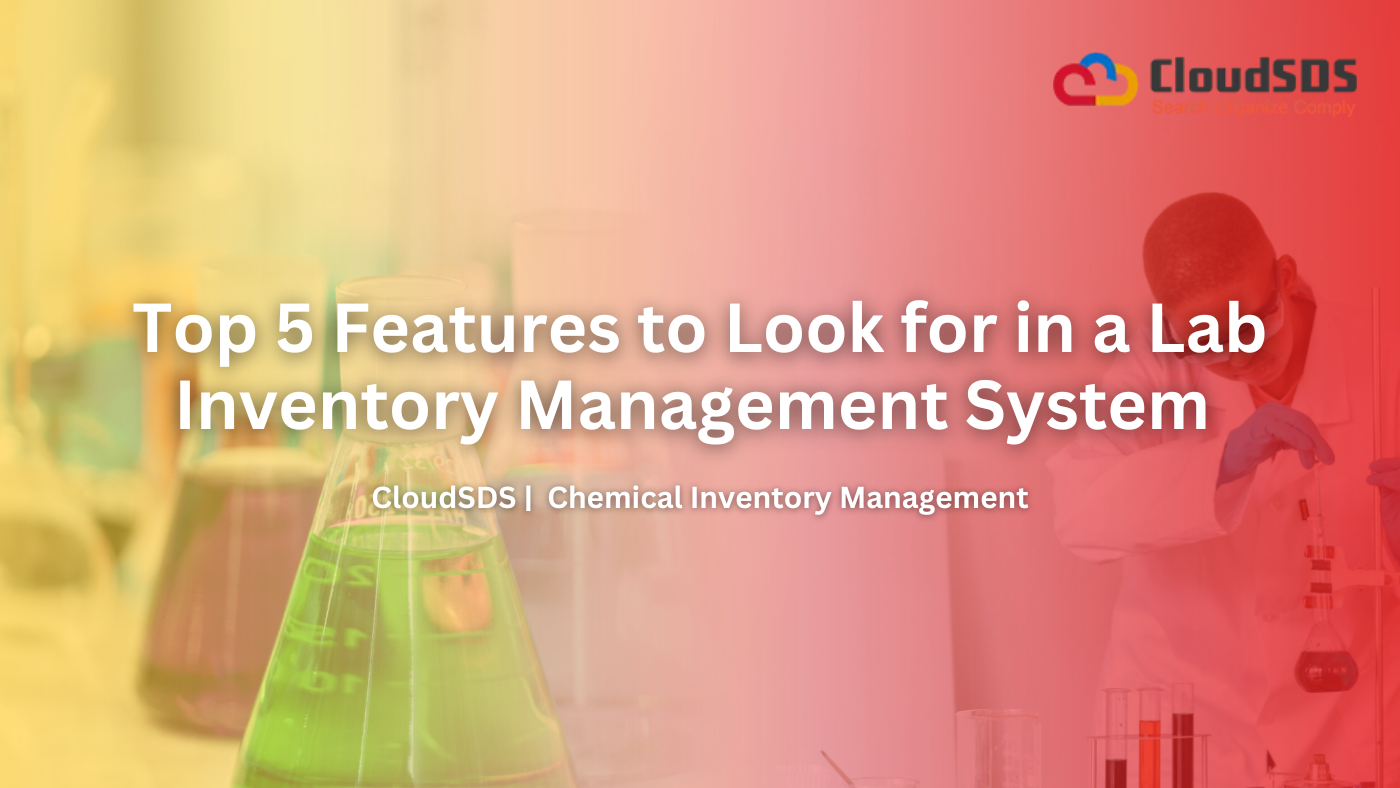Introduction:
Managing lab inventory efficiently is a critical task these days as it involves laboratory supplies, chemicals, reagents, instruments, and consumables. Not only in academic, pharmaceutical, biotech or chemical sectors- cases of accidents (Sheri Sengji at UCLA) come into highlights these days. That’s why it must be tracked accurately to maintain safety, compliance, and productivity. As labs scale up their operations and data, traditional safety data sheet tracking quickly becomes error-prone and inefficient. That’s where a Lab Inventory Management System (LIMS) comes into play.
A well-designed lab inventory management system simplifies workflows, improves regulatory compliance, and ensures that critical supplies are always available when needed. But with so many options available, which one would be perfect?
This blog will delve into the top 5 features to look for in a lab inventory management system aimed at streamlining lab operations and future-proofing processes.
Check out the top 5 Features to Look for in a Lab Inventory Management System
1.Real-Time Chemical Inventory Tracking with Barcode Integration Facility
Efficient inventory tracking is foundational to any successful lab operation. By integrating barcoding and QR codes, labs can link chemical containers directly to their corresponding SDS and storage requirements.
Key Benefits:
- Accurate Tracking: Each chemical container is uniquely labeled and tracked through barcodes/QR codes.
- Direct SDS Access: Employees can scan a code to instantly retrieve the associated SDS, hazard pictograms, and storage guidelines.
- Minimized Human Error: Automated scanning reduces mistakes common in manual logging.
- Audit Trail: Each use or movement of a chemical is logged, maintaining a traceable history.
Why it is Important: The ability to track chemicals accurately and ensure quick access to SDSs minimizes exposure risks and supports regulatory compliance. It also improves lab efficiency by simplifying stock replenishment and tracking usage.
2. Regulatory Compliance Facility
Laboratories must comply with a multitude of safety and environmental regulations like OSHA, GHS, REACH, and EPA standards. A Cloud SDS-powered inventory system ensures that all required documentation is up to date, accessible, and formatted correctly.
Key Benefits:
- Regulatory Alignment: Automatically ensures SDS formats comply with GHS, OSHA, and international standards.
- Inspection Readiness: Easily generate compliance reports and documentation during inspections.
- Custom Alerts: Receive alerts when SDSs are about to expire or when regulatory changes affect stored chemicals.
- Version Control: Maintains historical versions of SDSs, showing the evolution of safety data over time.
Why it is important: Non-compliance can lead to legal penalties, reputation damage, and halted operations. With Cloud-based SDS integration, labs are always audit-ready and compliant with local and global regulations.
3. Smart Storage Management and Location Tracking Facility
Many labs store hazardous materials across multiple locations, rooms, and campuses in scattered ways. It creates confusion. Managing these storage sites effectively is critical to maintaining safety and avoiding cross-contamination or improper storage.
Key Benefits:
- Location Mapping: it is easier to assign chemicals to specific cabinets, freezers, or rooms in a simpler way.
- Safety Alerts: This tracking system Notifies the users if chemicals are stored in incompatible zones.
- Environmental Monitoring: This tracking system integrates with sensors and can help track temperature, humidity, and other conditions critical to chemical stability.
- Linked SDS Access: Storage locations are linked to the relevant SDSs to ensure correct handling and separation of incompatible substances.
Why it is important: In emergencies, knowing exactly where a chemical is linked, can save lives. Cloud SDS management integrated with smart storage tracking offers visibility and control across the entire laboratory.
4. User Access Controls and Role-Based Permissions Facility
Not everyone in a lab needs the same level of access to chemical inventory or safety documents. For example, a lab technician may only need to see basic chemical details, while a safety officer or lab manager may need full access to all documents and data. With a lab inventory management system, it’s easier to set up and control who can access what.
Key Benefits:
- Role-Based Permissions: Assigning different access levels to researchers, lab managers, safety officers, and auditors.
- Activity Logging: Keeping track of who accessed or modified SDS data.
- Secure Data Sharing: Sharing SDSs and chemical records with third parties (auditors and partners) in a secure way.
- Emergency Access: System administrators grant emergency override permissions to safety officers during critical incidents.
Why it is important: Accessing control is not only a best practice but often a regulatory requirement. Limiting SDSs and chemical access to authorized users improves overall lab safety and protects intellectual property.
5. Flawless Integration with EHS, LMS, and ERP Systems Facility
A scalable lab inventory management system should also integrate with Learning Management Systems (LMS), Enterprise Resource Planning (ERP) platforms, Environmental Health and Safety (EHS) systems, Procurement systems and chemical catalogs.
Key Benefits:
- The integration system automatically syncs chemical usage data with LMS for improved experimental tracking.
- It consolidates procurement, inventory, and compliance reporting in ERP.
- Lab managers or EHS officers can centralize safety initiatives by integrating the Learning Management System with EHS platforms.
These integrations ensure that all aspects of lab operations, from procurement to disposal, are aligned, optimized, and compliant.
Why It is important:
Such integrations foster a unified digital lab ecosystem, improve procurement accuracy, and streamline compliance reporting across systems.
Conclusion:
Selecting the right lab inventory management system is a crucial decision that impacts the lab’s productivity, safety, and compliance. Whether it is about setting up a new lab or upgrading from manual systems, focusing on these top 5 features, real-time tracking, role-based permissions, regulatory compliance, and integration with EHS and LMS, will ensure long-term value. In a time where lab safety and data accuracy are non-negotiable, choosing the right lab inventory management system is a critical decision.
To get the most out of the system, lab managers should consider their lab’s unique workflows, regulatory requirements, and team structure. A scalable, customizable solution will pay for itself many times over by reducing waste, improving efficiency, and keeping their operations audit-ready.

Leave A Comment